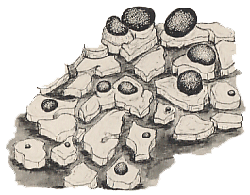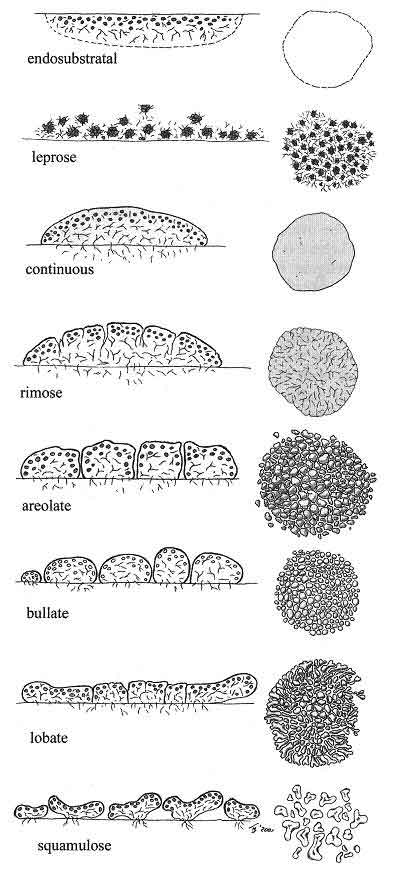 Form and structure
Form and structure
Crustose lichens
Foliose and fruticose lichens are clearly three dimensional and show much obvious variation in form. The markedly two-dimensional crustose lichens have less scope for showing as much variation but all crustose lichens are not just uniform flat sheets and warrant a page devoted to some of the structural variation in the crustose species. The illustrations along the right hand side of this page show some of the crustose growth forms and the terms used to describe them. The left-hand illustration of each horizontal pair shows a cross section through a crustose thallus and the right-hand illustration shows the same thallus viewed from above. These illustrations were produced by Frank Bungartz and have been copied, with permission, from the source given in the following reference button![]() .
.

Whereas the thalli in most lichens develop on the substrate, an endosubstratal thallus develops within the substrate ![]() , for example in finely fissured wood or porous rock. In the left-hand illustration of the first row the straight horizontal line indicates the surface of the substrate. Almost immediately below the surface are the dark dots indicating a layer of photobiont cells, then the short streaks indicating some of the hyphae in the thallus and the broken line indicates the lower extremity of the thallus. If viewed from above there is often little to see except what appears to be a slight discoloration of the substrate, though spore-producing structures such as apothecia and perithecia would typically develop on the surface. The rest of the forms illustrated here grow on the substrate. Leprose lichens, such as the species of the genus Chrysothrix
, for example in finely fissured wood or porous rock. In the left-hand illustration of the first row the straight horizontal line indicates the surface of the substrate. Almost immediately below the surface are the dark dots indicating a layer of photobiont cells, then the short streaks indicating some of the hyphae in the thallus and the broken line indicates the lower extremity of the thallus. If viewed from above there is often little to see except what appears to be a slight discoloration of the substrate, though spore-producing structures such as apothecia and perithecia would typically develop on the surface. The rest of the forms illustrated here grow on the substrate. Leprose lichens, such as the species of the genus Chrysothrix ![]() . have a powdery or granular appearance. In the two views of a leprose thallus (on the right) each dark dot indicates a small clump composed of some photobiont cells and fungal hyphae. As you could deduce from the illustration, there is little organisation in the thalli of leprose lichens and often the thallus boundaries are not sharply delimited. The remaining forms shown here have thalli with well-delimited boundaries. The first of these is a crustose lichen with a continuous thallus. Here, as in the remaining illustrations, the dots near the surface indicate the photobiont cells. A continuous thallus has few breaks in the thallus whereas a rimose thallus is marked with irregular, narrow, shallow fissures. Initially you might think that the areolate thallus is an extreme form of a rimose thallus, the fissures having extended through the thallus. One difference between the two illustrations is that each section (or areole) of the areolate thallus has photobiont cells along the upper surface as well as down the sides, so that the opposite sides of each 'fissure' bear photobiont cells. That's not the case with the rimose thallus. A rimose thallus arises from the fissuring of an otherwise continuous thallus whereas in the areolate thallus the separate areoles develop independently, perhaps on a common hypothallus. In a number of lichen species the thallus develops on a basal layer (or hypothallus) of dark-pigmented, non-lichenized hyphae. In such cases, as the thallus expands, the non-lichenized hypothallus is always a little ahead of the expanding lichenized thallus and can be seen as a dark fringe at the margin of the thallus. In this photo
. have a powdery or granular appearance. In the two views of a leprose thallus (on the right) each dark dot indicates a small clump composed of some photobiont cells and fungal hyphae. As you could deduce from the illustration, there is little organisation in the thalli of leprose lichens and often the thallus boundaries are not sharply delimited. The remaining forms shown here have thalli with well-delimited boundaries. The first of these is a crustose lichen with a continuous thallus. Here, as in the remaining illustrations, the dots near the surface indicate the photobiont cells. A continuous thallus has few breaks in the thallus whereas a rimose thallus is marked with irregular, narrow, shallow fissures. Initially you might think that the areolate thallus is an extreme form of a rimose thallus, the fissures having extended through the thallus. One difference between the two illustrations is that each section (or areole) of the areolate thallus has photobiont cells along the upper surface as well as down the sides, so that the opposite sides of each 'fissure' bear photobiont cells. That's not the case with the rimose thallus. A rimose thallus arises from the fissuring of an otherwise continuous thallus whereas in the areolate thallus the separate areoles develop independently, perhaps on a common hypothallus. In a number of lichen species the thallus develops on a basal layer (or hypothallus) of dark-pigmented, non-lichenized hyphae. In such cases, as the thallus expands, the non-lichenized hypothallus is always a little ahead of the expanding lichenized thallus and can be seen as a dark fringe at the margin of the thallus. In this photo ![]() of Rhizocarpon geographicum you can see an areolate growth form. The areoles are yellow and many of them have round, black apothecia. The areoles sit on a black hypothallus and the irregular black lines between the areoles are in fact the hypothallus showing through the inter-areole gaps. In an areolate thallus the areoles may sometimes coalesce and, conversely the fissures in a rimose thallus my sometimes extend, so giving a rimose-areolate thallus, as in various species of the genus Diploschistes
of Rhizocarpon geographicum you can see an areolate growth form. The areoles are yellow and many of them have round, black apothecia. The areoles sit on a black hypothallus and the irregular black lines between the areoles are in fact the hypothallus showing through the inter-areole gaps. In an areolate thallus the areoles may sometimes coalesce and, conversely the fissures in a rimose thallus my sometimes extend, so giving a rimose-areolate thallus, as in various species of the genus Diploschistes ![]() . A bullate thallus is an areolate thallus with the areoles more rounded while the marginal areoles in the lobate thallus are more developed than the central ones and may be partially free of the substrate, giving a somewhat foliose look to the margin. The species Placopsis perrugosa
. A bullate thallus is an areolate thallus with the areoles more rounded while the marginal areoles in the lobate thallus are more developed than the central ones and may be partially free of the substrate, giving a somewhat foliose look to the margin. The species Placopsis perrugosa ![]() is a good example. The squamulose illustrations speak for themselves. Placidium squamulosum
is a good example. The squamulose illustrations speak for themselves. Placidium squamulosum ![]() is an example of a lichen with squamulose thalli.
is an example of a lichen with squamulose thalli.
The various terms used to describe lichen growth forms are very useful for descriptive purposes but there are not always sharp demarcations between growth forms, so allowing some variation in interpretation. For example in these illustrations the squamulose growth form is presented as a type of crustose thallus but other authors treat it as a separate growth form.
Form and structure pages on this website Crustose lichens |
![An Australian Government Initiative [logo]](/images/austgovt_brown_90px.gif)

